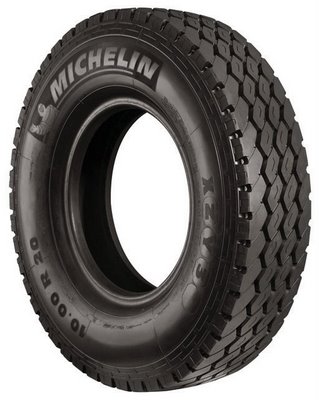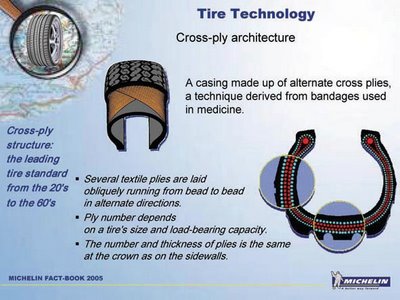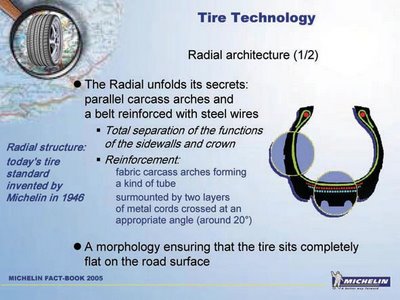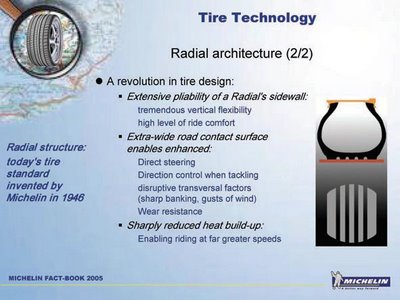 In an era of global warming and soaring crude prices, an increasing resort is made to tyre radialisation for commercial vehicles with a view not only to saving fuel costs but reducing emission of harmful green house gases and easing pressure on global oil reserves. Radialisation also ensures a longer life for tyres.
In an era of global warming and soaring crude prices, an increasing resort is made to tyre radialisation for commercial vehicles with a view not only to saving fuel costs but reducing emission of harmful green house gases and easing pressure on global oil reserves. Radialisation also ensures a longer life for tyres.
This is due to the phenomenon known as lowering rolling resistance. “As the wheel goes round, the tyre is deformed to make contact with the road. All the forces required for acceleration, braking and cornering are transmitted through this contact patch. As its structure is deformed, the tyre components heat up, and some of the energy transmitted by the engine is transformed into heat: this is the phenomenon of tyre rolling resistance.”
Rolling resistance is one of the five forces a vehicle must overcome in order to keep moving. The others are aerodynamic drag that depends on vehicle speed, inertia while accelerating, gravity when moving uphill and internal friction in rotating components. The challenge of low rolling resistance technology is to maintain a tyre’s performance in other areas, particularly safety and wear life. In today’s truck and bus tyre market, two standards exist. The first is cross-ply, or bias or nylon tyres, which is predominantly sold in India’s truck and bus market today. The body of the tyre called the carcass comprises of layers of rubber-coated nylon or rayon fabric called plies. In a cross-ply tyre, the fabric cords of the tyre criss-cross each other. The major reinforcing materials used are rayon and nylon tyre cords.
The challenge of low rolling resistance technology is to maintain a tyre’s performance in other areas, particularly safety and wear life. In today’s truck and bus tyre market, two standards exist. The first is cross-ply, or bias or nylon tyres, which is predominantly sold in India’s truck and bus market today. The body of the tyre called the carcass comprises of layers of rubber-coated nylon or rayon fabric called plies. In a cross-ply tyre, the fabric cords of the tyre criss-cross each other. The major reinforcing materials used are rayon and nylon tyre cords.
The main benefit of cross-ply tyres is the initial purchase cost being lower than a radial tyre. However, there are drawbacks, including faster wear, greater fuel consumption, lower vehicle steering control, and greater heating of tyres necessitating stops when travelling long distances.
In a radial tyre, the casing is composed of only one ply made of cords running from bead to bead at 90 degrees to the rolling direction and radially oriented relative to the centre of the tyre.
The secret lies in the parallel carcass arches and reinforced steel belts, allowing total separation of the sidewalls and crown functions: the sidewall and tread areas function separately and the tread is unaffected by the flexing of the sidewalls. This significantly reduces the rolling resistance of a tyre. This results in the ability to drive much more comfortably at much higher speeds without stopping, better steering control and better tyre wear.
The first truck tyre radial was launched in 1952 though the passenger car radial was patented by Michelin in 1946. The energy range of tyres, specifically designed to lower rolling resistance, were first launched by Michelin in 1992, and currently it is the fourth generation of low rolling resistance tyres.
Another key aspect which is less known is that the tyre actually plays a vital role in a vehicle’s energy consumption. At normal driving speeds, a tyre accounts for 30 per cent or more of a truck’s fuel consumption.
Radial tyres help to boost mileage considerably, and the result is a net saving of up to 10 per cent on fuel bills. That’s not a small amount considering that fuel costs account for up to 40 per cent of the cost of operation for trucks and buses.
In recent tests done on Michelin radial tyres versus bias tyres in different conditions across India, the fuel savings recorded was 4-10 per cent on average. Such a difference in the cost of operations makes it possible to amortize the higher purchasing cost of radials over the life of the tyre, and this therefore becomes a significant advantage of the radial tyre. 


Then the next advantage of using the Michelin truck radial technology is that after the tyre is worn out there is some extra rubber provided below the tread, which allows one to regroove the tyre. This enables the tyre to run a further 15-25 per cent. Radial tyres can also be retreaded quite easily. This, in turn, will provide 70-80 per cent more mileage (second life). After the second life the whole cycle of regrooving & retreading can be repeated. This allows one to get a significantly lower cost per km.
Opportunities in India
As India continues its steady economic ascent, chalking up an annual growth rate of around eight per cent annually, one of the key drivers for growth will be the effective and efficient mobility of people and goods. Of course there are restraining factors for radialisation, but at the same time opportunities are plentiful.
Among other factors that limit the pace of radialisation is the road condition. Transport congestion, with stop and go, low average speed, poor average distance per day, etc., are other deterrents. Though there is a lot of progress at the Golden Quadrilateral, major bottlenecks hit inter-State movement of people and goods. Maintenance of certain vehicles, geometry maintenance and size of rims may not be favourable to radials as tyres are to be more sensitive to misalignment. This can create uneven wear and reduce the mileage potential. Further, radialisation may be affected by the rising input and fleet maintenance costs.
On the other hand, opportunities for radialisation start with the legal environment, the right road infrastructure which is being strengthened and improved transportation facilities.
However, overloading used to be rampant everyday in the trucking industry, and regardless of the tyres used overloading will cause tyre damage, shorten tyre life, crack rims, and cause accidents due to poor vehicle handling. Overloading also damages the road infrastructure over time. It was not uncommon in India for a vehicle with a maximum load capacity of nine tonnes to carry up to 13 tonnes. It is estimated that a 30 per cent reduction in the life of the highway.
Now with the Supreme Court’s judgment of November 2005 against overloading of trucks and goods vehicles, it is expected that there will be a lot of re-positioning in different tyre segments, and we can foresee a push towards ‘radialisation’ of truck tyres. The scenario will encourage the trucking industry to increase the use of radials. Greater acceptance and fitment of radial tyres by original equipment manufacturers is expected to bring about the transformation in radialisation of the truck and bus segment in India.
The increasing number of multi-axle vehicles (MAVs) is considered another important factor that will give an impetus to radialisation in the CV segment. MAVs are capable of carrying at least 50 per cent more loads compared to no
rmal trucks. This will help reduce the turnaround time.
An additional need to help with the smooth transition for radialisation is the need to provide the right level of information and training to both dealers and end-users. For dealers, it would mean ensuring that the products are matched by the right level of service and technical know-how. For end-users, generating the right awareness on the benefits and usage of radial products will be the key. For Michelin, this component of personal education will play a vital role in its progress in India.
In India, one of the fastest-growing economies in the world today, radialisation is almost complete as far as the passenger car tyres segment is concerned, and is starting to gain momentum in the truck and bus tyres segments. India’s tyre industry has grown rapidly, and is today estimated to be around Rs. 20,000 crores and a sizable percentage of new investment in India’s tyre industry will be spent on improving the radial tyre segment, both for passenger car, as well as for truck and bus.
The future of radialisation in the Indian tyre industry is widely acknowledged to be promising in the commercial vehicle tyre segment. In any case, progress in radialisation, especially the pace of transformation of the market, will be governed by factors like the road infrastructure improvement, overloading control, radial fitments by original equipment manufacturers, the service network.
And even today, with its ability to last longer and depending on conditions sometimes twice as long as a cross ply tyre, operate without over-heating, and save a significant percentage of fuel cost in the process, the switch to radials may happen faster than anticipated.
More than half of all truck tyres in the world are radial truck tyres, as per Michelin estimates. The Asian rate of radialisation is also up at 50 per cent. Markets like Thailand and China, this radialisation rate is upward of 30 per cent. India alone accounts of seven per cent of the world truck tyre consumption. Nevertheless, in 2005, the rate of radialisation was under one per cent and in today’s time it is conservatively estimated as five per cent. In our mind it is just a matter of time. Since this technology provides tangible benefits to the consumer and addresses his top of mind concerns, Radialisation can only increase. India is today poised to join the radial revolution. This technology will pave the way towards achieving sustainable mobility in the country.
This radialisation drive is closely linked with modernization of heavy vehicle fleets, for this is where the strength of radial tyres ties. Add to that the improvement of the Indian road infrastructures, an area where we have seen significant progress in the last few years, the need for radial tyres will become more and more a necessity rather than a luxury. This is one technology which benefits the individual directly and at the same time helps conserve the environment and precious natural resources. In today’s context we feel these two strong reasons will be the key drivers for Radialisation in India.
With over 115,000 employees and sales organizations in more than 170 countries, including India, Michelin is one of the world’s largest tyre manufacturers. Dedicated to the improvement of sustainable mobility, Michelin designs, manufactures and sells tyres for every type of vehicle, including airplanes, automobiles, bicycles, earthmovers, farm equipment, heavy-duty trucks, motorcycles and the US space shuttle, on 69 production sites in 19 countries throughout five continents. The company also publishes travel guides, hotel and restaurant guides, maps and road atlases and offers electronic mobility support services, on ViaMichelin.com. Research and innovation development is being taken care of in technology centres in Europe, the US and Japan.
For Michelin, the need to innovate and contribute to the improvement of mobility is a part of the organization’s genetic code. Its mission is to contribute to the mobility of people and goods by facilitating greater freedom, safety, efficiency and enjoyment of travel.